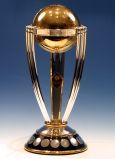Mongoose Madness
Fri, May 13, '05

For the citizens of Grenada at least, the mongoose will always have negative connotations. Which Grenadian today - who was alive during the Eric Gairy regime - can forget the terror meted out by the state-sponsored Mongoose gang?
Yet, according to a Barbados Nation report, the mongoose was proposed as the mascot for World Cup 2007. The mongoose has already been submitted to the ICC for approval and, if the report is accurate, the final go-ahead could come very soon from the Cricket World Cup 2007 board of directors.
For some background, let me tell you about Dr. Alistair Hughes. He is a Grenadian journalist who in 1973 was waiting for then Prime Minister Sir Eric Gairy to return from discussions with the British government on Grenada's pending Independence. The journalist was dragged from his taxi, beaten by Gairy's Mongoose Gang, and kicked out of Pearl's airport.
Again, on January 21st 1974, Dr. Hughes was among a crowd of about 6,000 taking part in a public protest outside Otway House, headquarters of the Seamen and Waterfront Workers Union (SWWU) on the Careenage. The demonstrators were beaten, tear gassed, and shot at by Gairy's Mongoose gang. This band of thugs fashioned along the lines of the more infamous "Ton Ton Macoute" of Duvalier's Haiti, for decades, revelled in fear and intimidation of the people of Grenada, and were responsible for countless acts of untold brutality.
It is surprising then, that organizers of the ICC Cricket World Cup (2007) would propose such a symbol as the mascot. Bear in mind, a leg of the tournament has been granted to the Spice Island.
In addition, the mongoose is not even native to the West Indies; rather, it was introduced into the Caribbean islands in the 1800s by owners of the sugar plantations, in a bid to rid the plantations of rats. The law of unintended consequences dictated that as much as the mongoose was able to keep the rat population under control in the Caribbean, it also had a harmful effect on such birds as the white-bellied dove of Jamaica, the "Red Neck" Pigeon, and the common Turkey Buzzard or as it's more commonly known, the "John Crow."
Surely, some consideration should have been given to the Scarlet Ibis, which also happens to be one of the native birds of Trinidad and Tobago, and is also endangered, having not been breeding in any significant numbers since the 1960s, because of illegal hunting for its meat and feather, coupled with loss of some of it's natural habitat which together served to put a huge dent in its numbers.
Here was an opportunity for the organizers of the World Cup to educate West Indians about an important part of their heritage, and the importance of conserving the flora and fauna from the ravages of man, and to also highlight the wondrous habitat of the Scarlet Ibis, the Caroni swamps where Ibises used to "blot out the sky, they were so many."
The colorfulness and the uniqueness of this most beautiful of birds would lend itself well to any marketing campaign, better than the nocturnal mongoose, which when sighted, reminds one more of the common brown rat. The Mongoose is also linked with trickery and thievery as any West Indian chicken farmer could attest to, having had their young chicks and eggs devoured by the "sly" Mongoose.
One would hope that the largest event ever hosted by the Caribbean wouldn't want as its mascot an animal known for slyness and thievery as opposed to a beautiful animal like the Scarlet Ibis. In a word, any ground nesting bird, chicken, lizard and even crabs aren't safe from the mongoose.
So there you have it, in the crazy world of West Indian cricket, an animal that in many parts of the Caribbean is considered a thief and a pest, and commonly shot on sight if it shows itself in the wrong places, is being considered as the Mascot for the largest sporting event that we have ever undertaken. Hopefully the reputation that bedevils the mongoose is not indicative of the mindset of the organizers of the ICC Cricket World Cup (2007).
Chris Dehring and his staff would do well to reconsider this idea well before the meeting on July 19th to unveil the mascot.